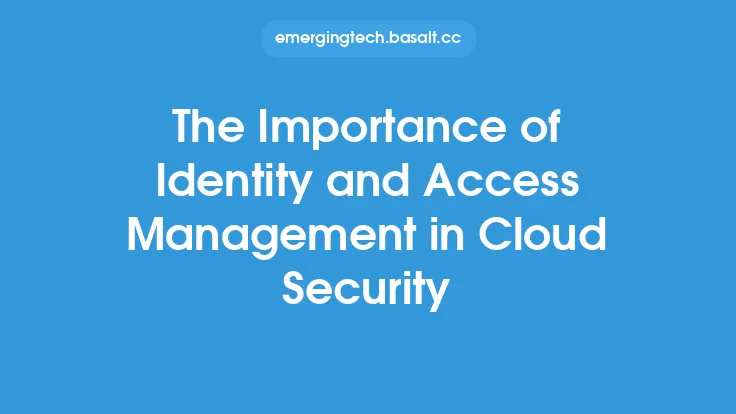Identity and Access Management (IAM) is a critical component of cybersecurity that enables organizations to manage and control user access to their resources, systems, and data. It is a set of processes, technologies, and policies that work together to ensure that the right users have the right access to the right resources at the right time. In this article, we will delve into the world of IAM, exploring its key concepts, components, and benefits, as well as the challenges and best practices associated with implementing an effective IAM system.
Introduction to Identity and Access Management
IAM is a broad term that encompasses a range of technologies and processes, including authentication, authorization, accounting, and auditing. It is designed to provide a secure and efficient way to manage user identities and access to resources, while also ensuring compliance with regulatory requirements and organizational policies. IAM systems typically consist of several key components, including identity repositories, authentication servers, authorization engines, and auditing tools. These components work together to provide a comprehensive IAM solution that meets the needs of organizations of all sizes and types.
Key Components of Identity and Access Management
There are several key components that make up an IAM system, including:
- Identity repositories: These are databases or directories that store information about users, their identities, and their access rights. Examples of identity repositories include Active Directory, LDAP, and databases.
- Authentication servers: These are systems that verify the identity of users and authenticate their access to resources. Examples of authentication servers include RADIUS, Kerberos, and OAuth.
- Authorization engines: These are systems that determine what access rights a user has to a particular resource. Examples of authorization engines include role-based access control (RBAC) and attribute-based access control (ABAC).
- Auditing tools: These are systems that monitor and log user activity, providing a record of all access requests and outcomes. Examples of auditing tools include log management systems and security information and event management (SIEM) systems.
Benefits of Identity and Access Management
Implementing an effective IAM system can provide numerous benefits to organizations, including:
- Improved security: IAM systems help to prevent unauthorized access to resources and data, reducing the risk of security breaches and cyber attacks.
- Increased efficiency: IAM systems automate many of the tasks associated with managing user access, reducing the administrative burden on IT staff and improving productivity.
- Enhanced compliance: IAM systems help organizations to meet regulatory requirements and industry standards, reducing the risk of non-compliance and associated penalties.
- Better user experience: IAM systems provide users with seamless and secure access to the resources they need, improving their overall experience and productivity.
Challenges of Implementing Identity and Access Management
While IAM systems offer many benefits, implementing them can be challenging. Some of the common challenges associated with IAM implementation include:
- Complexity: IAM systems can be complex and difficult to implement, requiring significant expertise and resources.
- Cost: IAM systems can be expensive to purchase and maintain, requiring significant investment in hardware, software, and personnel.
- Integration: IAM systems often require integration with existing systems and applications, which can be time-consuming and challenging.
- User adoption: IAM systems can require significant changes to user behavior and workflows, which can be difficult to implement and manage.
Best Practices for Implementing Identity and Access Management
To overcome the challenges associated with IAM implementation, organizations should follow best practices, including:
- Developing a clear IAM strategy and roadmap
- Conducting a thorough risk assessment and gap analysis
- Selecting the right IAM technologies and vendors
- Implementing a phased rollout and testing approach
- Providing training and support to users and administrators
- Continuously monitoring and evaluating the effectiveness of the IAM system
Identity and Access Management Technologies
There are many different IAM technologies available, each with its own strengths and weaknesses. Some of the most common IAM technologies include:
- Single sign-on (SSO) solutions: These provide users with access to multiple applications and resources with a single set of credentials.
- Multi-factor authentication (MFA) solutions: These provide an additional layer of security by requiring users to provide multiple forms of verification, such as a password and a fingerprint.
- Identity federation solutions: These enable organizations to share identity information and authenticate users across different domains and systems.
- Cloud-based IAM solutions: These provide a scalable and flexible way to manage user access to cloud-based resources and applications.
Identity and Access Management Standards and Regulations
IAM systems must comply with a range of standards and regulations, including:
- NIST Special Publication 800-63: This provides guidelines for electronic authentication and identity verification.
- ISO/IEC 27001: This provides a framework for implementing and managing an information security management system (ISMS).
- GDPR: This regulates the processing and protection of personal data in the European Union.
- HIPAA: This regulates the protection of sensitive health information in the United States.
Conclusion
In conclusion, Identity and Access Management is a critical component of cybersecurity that enables organizations to manage and control user access to their resources, systems, and data. By understanding the key concepts, components, and benefits of IAM, organizations can implement an effective IAM system that meets their needs and provides a secure and efficient way to manage user access. While implementing an IAM system can be challenging, following best practices and selecting the right technologies and vendors can help to overcome these challenges and ensure a successful implementation.





